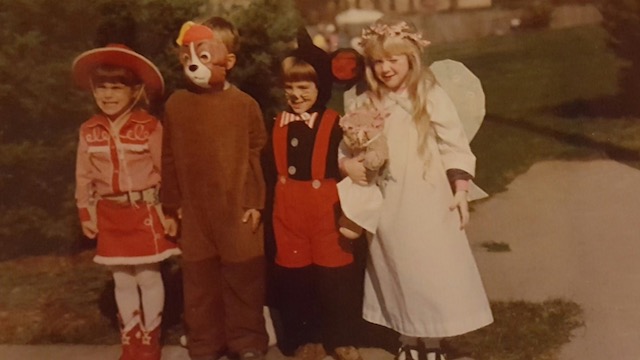Halloween. Samhain. Hallowmas. All Hallows’. Día de los Muertos.
The day draws near, but do you know its origins? This time of year has so many names and so many traditions spread across many different cultures, and here in the U.S. we have our own version of this holiday which has grown from a marriage of various cultures, especially the Irish and other European immigrants who carried on the traditions of their Pagan ancestors.
Costumes, trick-or-treating, pumpkin carving, ghosts, goblins, candy, apple bobbing, corn mazes, It’s the Great Pumpkin, Charlie Brown, candy corns (ugh!), The Worst Witch, Michael Meyers, black cats, and witches. As children, Halloween was innocent, and as we got older it presented a chance to push the limits and let our inner freak out.
I’ve been dressing up in costumes on Halloween since my earliest memories. I remember back in the 80s we had these horrible plastic bag costumes with plastic masks which had horrible eyeholes and mouth holes cut out, or we had a homemade costume.
Funnily enough, as kids, we wanted the plastic masked ridiculousness from the local drug store because that’s what everyone else was wearing. Now when I look back, I have a real appreciation for that cowgirl costume put together piece-by-piece when I was just a Pre-K tot. Or the later years, as I approached third grade, when Poison, Cyndi Lauper, and Def Leppard were my idols—so I was a punk rocker, with legit rocker clothes, every single year for like four years.
I remember it used to be cold on Halloween in New Jersey, and we’d resist Mom’s advice to wear a jacket over our fabulous costumes. Like, no Mom, don’t you know I need to look cool and a jacket just lowers my cool factor? We’d binge watch Halloween movies, vacillating between scaring ourselves silly and pretending we were witches.
After 9 p.m. all the older kids would come knocking and wearing the scary, gory costumes and I would be afraid to answer the door. Our parents would check our candy for tampering after creeps starting drugging and poisoning Halloween candy. And of course, there was the ever prevalent myth of the creep who slid razor blades into treats. I mean, who does that? We’ll never know if it was urban legend or not, I guess.
Even as a kid, before I knew any of the history surrounding our favorite holiday, I felt the pull of the darkness. I felt the whispers and the beckoning from those beyond the veil during this time of year. So naturally when I came to learn the origins of Halloween, they all made sense to me! Which is why I want to share these facts and origins with you in time for this most special point on the Wheel of the Year.
- The festival of Samhain (Celtic feast day) pre-dates most modern religions. As Christianity spread after the Dark Ages, the church incorporated more and more Pagan feast days into their calendar to lure pagan followers into conversion, and to placate those being forced to convert. Thus the Christian All Souls’ Day and All Saints’ Day (aka All Hallows, Hallowmas, etc.) were born. A day to honor and revere our faithful departed kin. It’s the Christianized version of celebrating the connection between the living and the dead. Through a marriage of these two traditions, modern Halloween was born.
- In the eighth century, Pope Gregory III designated November 1st as a time to honor all saints and martyrs; the holiday, All Saints’ Day, incorporated some of the traditions of Samhain. The evening before was known as All Hallows’ Eve and later Halloween.
- The October 31st sunrise (Samhain) aligns with the Mound of the Hostages at the Hill of Tara in Ireland. This Neolithic Passage is dated to 34oo BCE! Many important events in Irish mythology begin on Samhain, so it seems no coincidence that this midway point between the Autumnal Equinox and Winter Solstice aligns with the sunrise.
- It is believed, especially in the ancient Pagan beliefs, that during the window of October 31 through November 1, the veil between the worlds of the living and the dead is at its thinnest. This is where the festivals of Dia de los Muertos and All Souls’ Day have their roots.
- Interestingly enough, history shows that ancient cultures far and wide held this day in reverence as a time to cross between worlds and make contact with the spirit realms.
- Our modern tradition of costumes evolved from the practice of mumming, or guising (disguising oneself) in order to shield and hide oneself from the spirits that were free to roam the Earth during this time.
- In Celtic lore, the souls of the dead were thought to revisit their homes seeking hospitality during Samhain. Feasts were had, and the souls of dead loved ones and relatives were summoned to attend. A place was set at the table for them with offerings of food and drink. These festivals also involved people going door-to-door in costume often reciting verses in exchange for food, which is where our modern tradition of trick-or-treating evolved from.
- The original jack-o-lanterns were turnips and potatoes carved by the Irish to frighten away the lost souls who were trapped between heaven and hell. This came from a legend told about a man named Stingy Jack who tricked the Devil several times over and was then doomed to walk the Earth forever.
- By 43 AD, the Romans had conquered much of the Celtic world, and through a combination of Roman and Celtic traditions, a holiday was born to honor the Roman Goddess of fruit and trees, Pomona, whose symbol was an apple. This is most likely where the tradition of bobbing for apples came from.
- In the late 1800s, Halloween in America was made into what we see today, a holiday less about the grim and grotesque and more about celebration, families, and fun. During the Victorian period there was a push to bring the superstitious side of Halloween to heel by bringing it up to a more G-rated community event. Through this community effort, Halloween was stripped of its religious and superstitious overtones by the start of the 20th century and much of the lore was buried. Although today, the scare factor has made a comeback, it is more about horror and fright than it is about the original beliefs surrounding the thinning of the Veil and spirits roaming the Earth.
I hope you enjoyed these tidbits of information, and that you will share them with someone else! Pass them on and let’s honor the origins of our traditions.
And please, share below what your favorite Halloween traditions are!
~
Author: Lindsay Carricarte
Image: Author’s Own
Editor: Travis May






Read 6 comments and reply